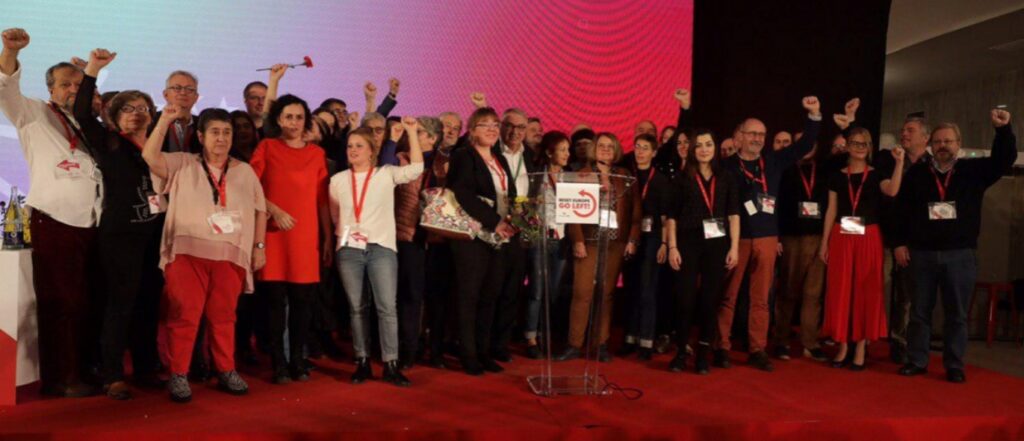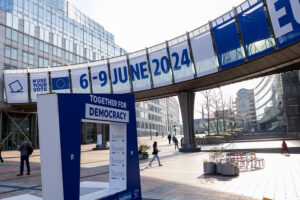Who are the representatives of the European Left and what do they stand for?
There are numerous documents published by transform! europe that analyse the electorate of the left parties in Europe, not least in the publication “Radical in Diversity: Europe’s Left 2010–2020”. The same cannot be said with regard to analyses of the European party representatives themselves and in particular of those of the European Left (EL). In order to close this gap, since the third party congress in 2010, transform! europe has been conducting surveys of delegates at each of the EL’s triennial party congresses. This is to enable a better understanding of the composition of delegates, how diverse left parties are at the European level, what the delegates stand for and where they see the greatest potential for common European action.
This article summarises all four surveys conducted at the party congresses in 2010 in Paris, 2013 in Madrid, 2016 in Berlin, and 2019 in Málaga. It is based on the analyses published on the transform! europe website.
It has not yet been possible to take into account the most recent crises, such as the Covid-19 pandemic and the war in Ukraine. Despite this limitation, a whole series of remarkable statements can be made about the actors, including reflections on their self-image, their socio-economic and socio-cultural position, and their attitude to the EU and to important European issues. Similar statements can also be made about the EL itself, its working methods and effectiveness at European and national level.
Continuity despite renewal
A remarkable paradox emerges: only about 10% of the current delegates co-founded the EL in Rome in 2004. Only 40% of 2019 delegates in Málaga participated in the 2016 congress in Berlin. So, there are always new delegates sent to the EL party congresses. Nevertheless, astonishing continuities can be observed with regard to the social composition of the delegates, their commitment and their political positioning. There are differences in the evaluation of the EL and above all in the weighting of new issues to be dealt with.
Age and social structure of the delegates
The delegates represent precisely the social milieus that they reach to a large extent at national level: the middle and lower social milieus of the party electorate and relevant parts of the “popular class”, especially from big cities.
The age structure is balanced over time across the various party congresses, i. e., even though new delegates are in the majority, the proportion of delegates up to 34 years of age and the proportion of delegates over 65 is about a quarter each, while the proportion of 35–64 year olds is about half. More than 70% come from big cities, with only 8.5% from smaller towns or rural areas.
The vast majority of delegates describe themselves as atheists or nonbelievers, less than 10% see themselves as believers. This is true for 2010 as well as for 2019.
A similar continuity can be found with regard to the social structure of the delegates: the share of full-time employees is around 45%. The proportion of people who are retired or pensioners is around 20% across the party congresses. The share of temporary workers has increased from 9% (2013) to 14% (2019). Around 7% are self-employed. Low proportions of certain groups remain almost constant, such as unemployed people at around 6% and university students at around 4%.
Farewell to the industrial worker: Only 6% of the delegates work in industry. This reflects the weak connection of the EL member parties to the classical industrial proletariat – as far as this still exists at all in the countries of South and Central Eastern Europe. The low proportion of skilled and semi-skilled workers (2.5% each) should also be seen in this context. The proportion of delegates working in agriculture is even lower.
High levels of formal education: Even though educational qualifications were not taken into account in the presentation of the evaluation of the 2018 questionnaire, it can be assumed in view of the job description that continuity is also apparent here. As can be deduced from the evaluations from 2010 to 2016, the proportion of academics is over 80%, which is at the same time associated with completely different income realities, including precarisation. In contrast, the proportion of delegates with a vocational qualification is significantly lower, at around 6%.
Middle class: Over 70% of delegates place themselves in the middle class, which also includes the upper middle class at around 5% and the lower middle class at over 17%. More than a quarter place themselves in the working class and about 4% in the lower social milieus. Expressed in terms of income, this means that 7.5% have an annual household income of over 100,000 euros and 7.5% between 100,000 and 70,000 euros (proportions that have increased since the last party congresses). More than half of the delegates have a household income between 20,000–70,000 euros. Among them we find mainly delegates from the southern EU countries with an income between 20,000–30,000 euros. Approximately one third of the delegates live in a household with an income of between 5,000–20,000 euros and this mainly concerns delegates from the countries of Central and Eastern Europe (CEE).
On the socio-political commitment of the delegates
Different political generations: Most respondents (59%) became members of their national parties in the last 20 years. This means that for the majority of EL delegates, the reasons for joining their parties coincide with protests against neoliberal policies to radically dismantle social infrastructures and the further intensification of the neoliberal agenda as a result of the financial and economic crisis of 2008–2009. Only one third of the respondents became politicised in the period from 1960–1989, i.e., in times of state socialism and bloc confrontation as well as military escalations and the threat of nuclear conflicts.
High positions of the delegates, low influence of the EL? More than 40% of the delegates belong to the highest bodies of their national parties, about 30% to high bodies, about 13% to mid-level bodies and only about 15–17% are members without a party function. This has not changed over the years. Interestingly, only about one third of the delegates see a “strong” or “very strong” influence of the EL on their own party. For 40%, this is “not that strong” and just under 20% see no influence on their own party.
Personal involvement in trade unions and social movements: A high degree of continuity is also evident among the delegates of the last four party congresses with regard to their political and social involvement. About 80% of the delegates are members of trade unions at national level. There are similarly high figures for membership of youth organisations (just under 80%). Up to 60% of the delegates belong or belonged to a social movement (peace movement, environmental movement) or were or are part of human rights organisations. The proportion of delegates active in feminist organisations is just over 30% – a figure that has increased by 10 percentage points over the years.
About 40% of the delegates participated in one of the European Social Forums. WSF, ATTAC or Alter Summit only play a role for 20% of the delegates.
On self-description
For the section on self-description, political orientation, for example as communists or anti-capitalists, is clearly more important (75%) than belonging to a certain social class (44%), gender (26%) or national identity (9.5%, with multiple answers possible).
Slightly more than half of the delegates (52%) saw themselves as members of their nation and European at the same time. This proportion has decreased in favour of those who select the option of only national identity. In 2019, this accounted for 19% of delegates, including mainly delegates up to 34 years of age. This trend was already apparent in 2016: 24% and 23% of delegates from Northern Europe and the CEE countries respectively and 23% of all delegates up to 34 years of age assigned themselves to only their national identity in 2016. On the other hand, the proportion of delegates who feel both European and national (with European mentioned first) has remained stable over the years at just over 20%.
At the party conference in 2019, just under 25% are “not very satisfied” with the state of the EU, and just under 70% said they were “not at all satisfied”. Only a third believe that their country benefits from the EU, while just under 40% do not think this is the case. Nevertheless, more than 70% do not think their country should leave the EU and this also applies to a slightly lesser extent to the eurozone.
Rights in Europe and other issues
Delegates, however, do also see numerous problems at the national level. The state of democracy was also questioned in 2019 against the backdrop of increasing right-wing developments in Europe. Almost 80% of delegates are dissatisfied with democracy in their countries and over 80% see strong or very strong far-right parties in their countries. The counterstrategies indicated are primarily the existence of left-wing structures in increasingly impoverished neighbourhoods and increased trade union involvement. Concrete options for action are primarily the political participation of migrants (approx. 80%), the implementation of multicultural approaches, and anti-fascist work.
When asked about individual political statements that have been made repeatedly over the years, there were very high levels of agreement among the delegates on certain issues: the right to abortion (almost 100%), that important industries and public services belong in public hands (almost 100%), the right that migrants should keep their customs (about 90%), the right to same-sex marriages (80%), that migrants make a contribution to their own country (just under 90%). These values were much lower in the past. The liberalisation of cannabis is now approved by about 70% of the delegates.
Ideological Positioning of the national parties
When asked about the ideology of their own (national) party, a differentiated picture emerges. The most frequently mentioned parties are the communist parties (over 30%). They are followed by socialist and anti-capitalist parties (over 20%) and progressive parties (10%). National parties play a much smaller role than ecological or feminist parties.
A large majority (90%) of the delegates see social movements not only as the closest allies of left parties but also as decisive actors in transformation (almost 70%, compared to the left parties with 64%). Surprisingly, when asked to identify the main agents of social transformation, only 32% answered with the traditional working class and only 30% said precarious workers. For delegates, this is more likely to be the case for youth and women, both with 48%. This highlights a double problem: on the one hand, the view of a rather conservative working class – especially the narrower core of the industrial proletariat – and, on the other hand, a lack of sustainable ties to them.
The left-right classification of the delegates, their national parties and the EL is also remarkable. Over the years, the majority of delegates place themselves between 1–2 on a scale of 1 (radical left) to 10 (extreme right). The majority of national parties sit at around 2 on the scale and the EL sits to the right of this, with shifts to the left between 2010 and 2016 to an average of 2.6.
In 2019, the survey asked whether the EL’s effectiveness had become stronger or weaker since the economic crisis of 2008–2009. About one third see EL as stronger than before, just under 20% see it as unchanged, and about 45% see EL as somewhat weaker or significantly weaker than before the crisis – a sober stocktaking.
Clear positions and the highest levels of agreement between the delegates of the member and observer parties can be found with regard to human rights and gender equality (90 %). The scores for the welfare state, unemployment, education, health and migration are somewhat lower. On the issues of environment and security and defence, only 60% and 58% respectively have common positions. Positions on inflation, the euro, energy policy and the issues of technology and science are also less clear and more ambiguous, and these
subject areas will also be strategically important for the EL in the long term. The lowest level of agreement is found on EU enlargement (30%).
In 2018, topics highlighted as needing attention included: environmental and climate policy (60%), social issues and dealing with the crises (30%), economy, taxes and migration (over 20%), international relations, unemployment, gender justice, human rights and health (between 10–15%). Security and defence policy, energy policy and pensions received lower scores. This will certainly change in the future as a result of the Ukraine war. At the same time, the ranking points to possible similarities.
The EL’s capacity for action
The EL’s political capacity for action is viewed very critically. 57% see it as “not strong” and 36% “not strong at all”. This means that well over 90% of delegates consider the EL, when measured against today’s challenges, to have insufficient strength as an actor. This is certainly linked to the deteriorating European framework conditions, to the resources of the EL at the European level, to its importance in shaping national left politics and to the significance of European politics in national struggles. Therefore, the question of how to increase the charisma and impact of the EL is urgent. Where are the greatest overlaps in terms of content in order to make European campaigns at all assertive?



